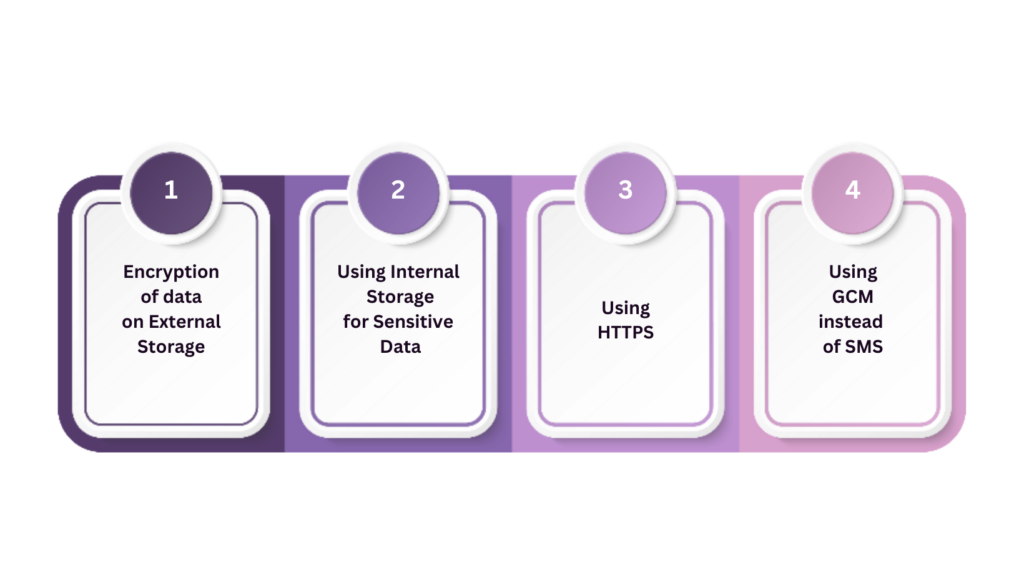Developing a groundbreaking mobile application marks just the initial phase in the comprehensive journey of mobile app development. Following the app’s construction, numerous indispensable procedures come into play, with mobile app security standing out as a pivotal focus.
In this article, we will delve into the crucial post-development practices essential for mobile app security, ensuring a robust and safeguarded application environment.
In the past decade, we’ve observed substantial growth in the mobile app development security industry, accompanied by a parallel rise in cybercrimes. Consequently, reaching a point where submitting an app to the Play Store or App Store requires implementing specific security measures has become inevitable.
The likelihood of an app being vulnerable extends beyond mere protection against malware and threats. To enhance our comprehension of security measures, let’s first pinpoint certain OWASP mobile app security threats.
Why do we need Mobile App Security: Potential Threats & Their Solutions
While the threats prevalent in the realm of app development may be malicious, straightforward measures can effectively address and secure mobile applications. Let’s delve into the primary issues concerning mobile app security.
1. Faulty server controls
The interactions occurring between the app and the user outside the mobile device transpire through servers, which frequently become prime targets for global hackers. The primary cause of server vulnerability often stems from developers neglecting essential server-side security measures.
Solution:
A pivotal measure in fortifying your servers involves conducting thorough app scans using automated tools. These scanners, which could otherwise be utilized by malicious actors to uncover vulnerabilities in your apps for exploitation, assist in identifying common issues and bugs.
2. The absence of Binary protection
Another significant concern among OWASP app security issues revolves around the absence of binary protection. When a mobile app lacks adequate binary protection, it becomes susceptible to malicious actors who can effortlessly reverse engineer the app’s code, introducing malware in the process. This opens the door for the distribution of pirated applications injected with threats, potentially causing severe consequences like data theft, harm to brand reputation, and subsequent revenue loss.
Solution:
To secure binary files, implementing binary hardening techniques is paramount. In this process, a thorough analysis of binary files is conducted, and necessary modifications are made to shield them from prevalent mobile app security threats. This procedure addresses vulnerabilities in the legacy code without necessitating any alterations to the source code. Ensuring security coding, including measures for jailbreak detection, checksum controls, and debugger detection controls, becomes crucial during mobile app security processes.
3. Data Storage Insecurity
A prevalent vulnerability in mobile app security is the lack of a secure data storage system. Mobile app developers often depend on client storage for internal data, which becomes easily accessible and manipulable when the mobile device falls into the hands of a potential adversary. This scenario can result in various crimes such as identity theft or PCI (external policy violation).
Solution:
An effective app security measure in this context involves implementing an additional layer of encryption on top of the operating system’s baseline encryption. This enhanced encryption layer significantly enhances data security.
4. Inadequate protection for Transport layer:
The transport layer serves as the conduit for data exchange between the client and the server. Without the implementation of appropriate mobile app security standards in this phase, unauthorized access by hackers to internal data becomes possible, potentially resulting in serious offenses such as identity theft and fraud.
Solution:
To enhance security at the transport layer, it is advisable to integrate SSL Pinning in both iOS and Android apps. Utilizing industry-standard cipher suites, instead of regular ones, is also recommended. Furthermore, adopting preventive measures such as refraining from exposing a user’s session ID due to mixed SSL sessions, promptly alerting users about invalid certificates, and employing SSL versions for third-party analytics are standard practices that effectively safeguard users against potential security breaches.
5. Unintended Leakage of data:
Unintended data leakage occurs when essential mobile applications are stored in susceptible locations on the mobile device. For instance, if an app is stored in a location easily accessible by other apps or devices, it can lead to a data breach in your app and unauthorized utilization of data.
Solution:
To mitigate unintended data leakage, it is crucial to monitor potential points of common data leakage, such as logging, app background processes, caching, browser cookie objects, and HTML5 data storage.
In addition to these five mobile development security threats, several other common obstacles hinder the creation of secure mobile apps. Here are some:
- Lack of multi-factor authentication – This process establishes multiple layers of security before granting access to an application. It may involve answering personal questions, using one-time passwords (OTPs), configuring SMS authentication, or implementing other measures. The absence of multi-factor authentication can lead to various issues, making it a crucial aspect of ensuring app security.
- Inadequate encryption practices – Proper encryption is a fundamental element of mobile application security best practices. The inability to implement it correctly can result in code theft, intellectual property theft, privacy violations, and various other problems.
- Malicious code injection – User-generated content, such as forms, is often underestimated as a threat. Apps that do not restrict the characters a user inputs expose themselves to the risk of code injection, potentially allowing unauthorized access to the server.
After acknowledging the common threats that affect mobile applications universally and identifying some of the best security practices to address these concerns, let’s now delve into the particulars of mobile application security for both Android and iOS platforms.
How to Make Android Apps Secure?
To ensure robust security for Android apps, consider implementing the following effective practices:

Encryption of data on External Storage –
Typically, a device’s internal storage capacity is limited, prompting users to utilize external devices like hard disks and flash drives for data storage. This data often includes sensitive and confidential information. Given that data stored on external devices is easily accessible by all device apps, it is crucial to store such data in an encrypted format. Mobile app developers commonly employ the Advanced Encryption Standard (AES) algorithm for this purpose.
Using Internal Storage for Sensitive Data –
Each Android application possesses an internal storage directory, where files are stored in the MODE_PRIVATE mode during creation. In simple terms, this mode guarantees that files belonging to a specific app remain inaccessible to other applications stored on the device. Consequently, prioritizing this mobile app authentication best practice is essential.
Using HTTPS –
For communications between the app and the server, it is imperative to use an HTTPS connection. Many Android users frequently connect to various open WiFi networks in public spaces, and opting for HTTP instead of HTTPS can expose the device to potential threats from malicious hotspots. These hotspots can manipulate the contents of HTTP traffic, leading to unexpected behavior in the device’s apps.
Using GCM instead of SMS –
Typically, a device’s internal storage capacity is limited, prompting users to utilize external devices like hard disks and flash drives for data storage. This data often includes sensitive and confidential information. Given that data stored on external devices is easily accessible by all device apps, it is crucial to store such data in an encrypted format. Mobile app developers commonly employ the Advanced Encryption Standard (AES) algorithm for this purpose.
How to Make iOS Apps Secure?
Storage of Data –
To streamline your app’s architecture and enhance its security, a highly effective approach is to store app data in memory rather than writing it to disk or transmitting it to a remote server. However, if local storage is the only viable option, there are various methods to consider:
Keychain:
For secure storage of limited quantities of sensitive data with infrequent access requirements, Keychain is the optimal choice. The OS manages data stored in keychains, ensuring it remains inaccessible to other applications.
1.Caches:
If your data doesn’t require backing up on iCloud or iTunes, consider storing it in the Caches directory within the application sandbox.
2. Defaults System:
The default system serves as a convenient method for storing substantial amounts of data.
Networking security :
Renowned for its robust security and privacy policies, Apple has diligently worked over the years to establish this reputation. Some years ago, Apple introduced App Transport Security, a measure compelling third-party mobile apps to transmit network requests exclusively over a more secure connection, namely HTTPS.
Security of Sensitive Information –
Most mobile apps leverage sensitive user data, including the address book, location, and more. However, as a developer, it is crucial to ensure that every piece of information requested from the user is genuinely necessary for both access and storage. If the required information can be obtained through a native framework, duplicating and storing that data becomes redundant.
We have explored mobile app security practices for both Android and iOS to create a hack-proof app. However, the reality of development is often more complex than it appears in writing. Every development process comes with its set of challenges. Let’s proceed and delve into the common challenges encountered and resolved by nearly every leading app development company in the USA.
Challenges Associated With Mobile App Security
The susceptibility of mobile apps to external malware is well-documented when adequate security measures are not implemented. The following challenges may arise at any time if mobile app security testing is not conducted according to the specified requirements.

Device Fragmentation –
Before releasing an application on app stores, it is imperative to adhere to essential processes. Diversifying across various devices with distinct resolutions, functionalities, features, and limitations is crucial in mobile app testing strategies. Identifying vulnerabilities specific to devices provides app developers with an advantage in implementing in-app security measures. It’s not only about devices but also considering different versions of popular operating systems is a vital step to address all potential loopholes before the app’s release.
Weak Encryptions –
In the case of weak encryption, a mobile device becomes susceptible to accepting data from any accessible device. Malicious attackers armed with malware are continually searching for vulnerabilities in public mobile devices, and your app could serve as such a vulnerability if a robust encryption process is not implemented. Therefore, dedicating efforts to robust encryption stands as one of the most effective methods to create a hack-proof mobile app.
Weaker hosting controls –
This issue commonly arises during the development of a business’s initial mobile app, often resulting in data exposure to server-side systems. Consequently, the servers hosting your app must implement sufficient security measures to prevent unauthorized users from accessing critical data.
Checklist for Mobile Application Security Guidelines
When constructing secure applications, every mobile app development security company typically adheres to certain practices. Here is a commonly followed checklist:
- Implement server-side authentication.
- Utilize cryptographic algorithms.
- Verify that user inputs conform to specified standards.
- Establish threat algorithms to safeguard data.
- Incorporate obfuscation techniques to deter reverse engineering.
Securing a mobile app against attacks from unknown sources involves numerous strategies, and no quantity of security measures can be deemed excessive. Exploring best practices in mobile app development security is a prudent approach. In today’s digital landscape, where the online world is accessible to everyone, no user is entirely immune to the threats of malware and security breaches. However, implementing these measures ensures the safeguarding of personal data on digital devices.


